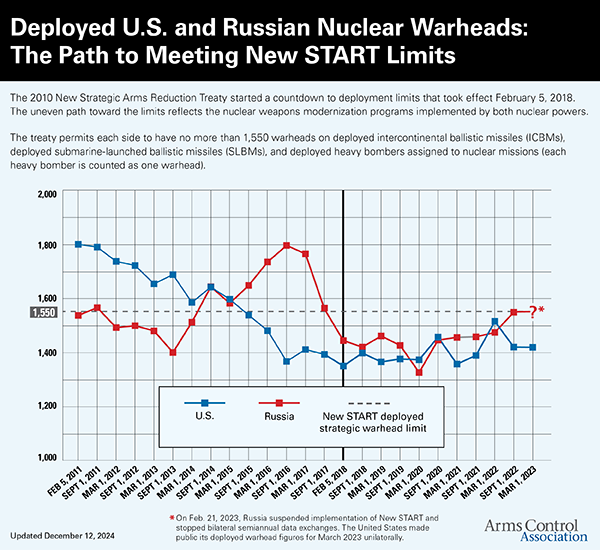Contact: Xiaodon Liang, senior policy analyst, [email protected]
On April 8, 2010, Russia and the United States signed the New Strategic Arms Reduction Treaty (New START). The treaty requires the sides to limit the number of deployed strategic nuclear warheads to no more than 1,550 and fielded delivery platforms to 700. The treaty also permits the United States and Russia to conduct 18 annual on-site inspections of facilities operated by the other country. Biannual data exchanges indicate the current state of their strategic forces. For a factsheet on Russian nuclear forces, click here.
Both the United States and Russia met these limits by the February 2018 deadline, and the limits will hold until February 2026.

As of March 1, 2023, the United States has 662 deployed strategic delivery systems, 1,419 deployed strategic warheads, and 800 deployed and non-deployed strategic launchers.
Under New START, the United States retains a deployed strategic force of up to 400 ICBMs, 60 nuclear-capable bombers, and 240 SLBMs.
- As of September 2022, the United States deploys 396 Minuteman III ICBMs, with 252 ICBMs in a non-deployed status, all of which have a single warhead. At any given time, an estimated 50 non-deployed silo launchers of ICBMs remain in a warm, operational status.
- Some bombers were converted to conventional-only missions (not accountable under New START), and 43 nuclear-capable bombers were deployed as of September 2022. Bombers are not on alert or loaded with weapons in peacetime, and New START counting rules allow each bomber to be counted as “one” deployed warhead, even though bombers can carry up to 16-20 nuclear weapons.
- The United States retains all 14 of its strategic nuclear submarines (SSBNs), although it reduced the number of SLBM launch tubes per SSBN from 24 to 20, for a total of 280 tubes across the entire fleet. Between two and four submarines are in dry dock at any given time. The United States deployed 220 submarine-launched ballistic missiles as of September 2022.
In addition to the treaty limit of 700 deployed systems, the treaty allows for 800 deployed and non-deployed missile launchers, and bombers. As of September 2022, the United States retains 454 deployed and non-deployed ICBM launchers, 280 deployed and non-deployed SLBM launchers, and 66 deployed and non-deployed heavy bombers.
The strategic forces that remain under the treaty are currently being upgraded or replaced. Over the 30 years, the administration plans to invest an estimated $1.7 trillion to modernize the nuclear weapons complex and nuclear delivery systems. For more on U.S. nuclear modernization, see U.S. Nuclear Modernization Programs.
Under New START, both sides release aggregate data on their stockpiles every six months.
